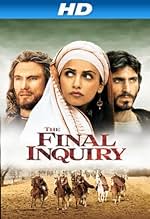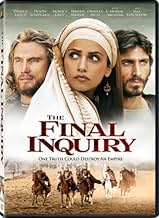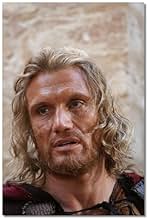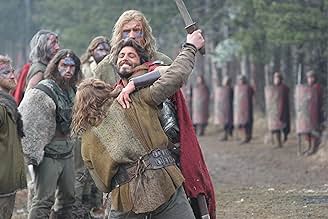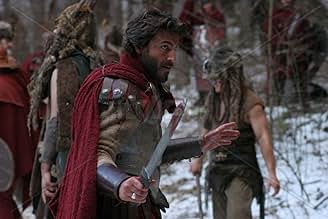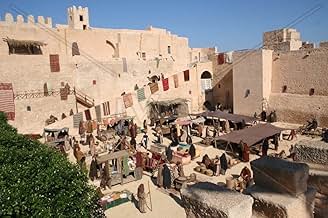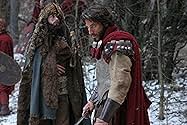NOTE IMDb
5,3/10
1,5 k
MA NOTE
En l'an 35, un tribun romain est envoyé en Palestine pour enquêter sur la mort et l'éventuelle résurrection de notre Seigneur Jésus de Nazareth.En l'an 35, un tribun romain est envoyé en Palestine pour enquêter sur la mort et l'éventuelle résurrection de notre Seigneur Jésus de Nazareth.En l'an 35, un tribun romain est envoyé en Palestine pour enquêter sur la mort et l'éventuelle résurrection de notre Seigneur Jésus de Nazareth.
- Réalisation
- Scénario
- Casting principal
- Récompenses
- 2 victoires au total
Avis à la une
If you enjoy Biblical film, you should enjoy this and add it to your collection. I'm not sorry I purchased it. Lundgren & Liotti are fabulous to look at and Monica Cruz is no slouch either (she looks just like her sister, Penelope).
The story-line is great. I wonder where the "Goofs" section is under "Fun Stuff" on IMDb, as this film was not devoid of them. For example, the rolling away of the massive stone at the tomb of Lazarus. It was done by one guy while another stood with a piece of lumber to assist by prying it but really did nothing, which would not have been possible. Some of the fight scenes just looked very badly done. There was a kiss scene wherein saliva strung from one person to another that would have been much more watchable had that been edited out. Finally, at the end, the terrain was striped by tire tracks and what looked like a radio tower on a mountain top.
The story-line is great. I wonder where the "Goofs" section is under "Fun Stuff" on IMDb, as this film was not devoid of them. For example, the rolling away of the massive stone at the tomb of Lazarus. It was done by one guy while another stood with a piece of lumber to assist by prying it but really did nothing, which would not have been possible. Some of the fight scenes just looked very badly done. There was a kiss scene wherein saliva strung from one person to another that would have been much more watchable had that been edited out. Finally, at the end, the terrain was striped by tire tracks and what looked like a radio tower on a mountain top.
The basic motif to see it was Max von Sydow. Unfortunatelly, he remains the only one. Because, not being real bad, it has the unluck to be a grey one, easy to ignore, easy to critic, easy to see it as remind of Quo Vadis , for Ursus becoming Brexus, for Taurus. The story remains conventional and, not so good, totally predictable. The acting is like the story - without spices or some salt. The love story sounds nice. But it only sounds. The life of first Christians and the effort of poor Tito Valerius for conquest the truth are decent points and the presence of the two Bulgarian actors reminds The Passion of Crist, another reasonable good point.
Short, a Christian film, modest but far to be awfull, well intentioned, having desire to have some targets - the cast remains the clue in this sense - but not being more than modest and decent.
Short, a Christian film, modest but far to be awfull, well intentioned, having desire to have some targets - the cast remains the clue in this sense - but not being more than modest and decent.
I saw the brilliant original by Damiano Damiani (http://www.imdb.com/title/tt0093255/) about twenty years ago. This is not a remake. Compared to the original screenplay, the story in this film is a joke in the best tradition of Hollywood, and it utterly does not follow the original plot.
This is a propaganda movie, a failed copy of the masterpiece by Damiano Damiani and a poor attempt to substitute real world values by thin air speculation and candy, pure Hollywood style. Nevertheless the movie has a value of its own, I have never seen Dolf Lundgren in a role like the one he took in this movie, and I could say that Monica Cruz play is not worse than her sister's, not to mention that Monica is somehow prettier than Penelope. It is a shame that Ornella Mutti did not participate in the original by her compatriot Damiano Damiani.
This is a propaganda movie, a failed copy of the masterpiece by Damiano Damiani and a poor attempt to substitute real world values by thin air speculation and candy, pure Hollywood style. Nevertheless the movie has a value of its own, I have never seen Dolf Lundgren in a role like the one he took in this movie, and I could say that Monica Cruz play is not worse than her sister's, not to mention that Monica is somehow prettier than Penelope. It is a shame that Ornella Mutti did not participate in the original by her compatriot Damiano Damiani.
First, I was unaware that this was a re-make. If the first movie is on DVD, I'll try it to see any difference. As to this movie (2006), I am going to write my usual bug-aboo about historical accuracy and the movies.
I wish just once that a film set in the period of Yeshua/Jesus would depict the Jewish people with a less than jaundiced - read: historically inaccurate - eye. I was confronted at the very opening of this film with yet another scene of "crazed Jews" stoning a woman for adultery. According to some extensive research on this period, I have learned that the imposition of the death penalty in ancient Jewish society was rare and could only be undertaken under very controlled conditions. For example, a woman caught in adultery was not automatically put to death. Both she and her husband had to appear before the Great Sanhedrin in Jerusalem - and only this body, with the consent of every single member, could actually pronounce the death sentence. One "no" vote and there was an acquittal. The husband could forgive his wife and take her back and that was the end of it. Or he could divorce her. If she was freed and committed adultery again, then the matter would be returned to the High Court. Trials took three days: testimony and evidence on the first day; deliberation by the court on the second, and the third day reserved for the verdict. This third day was meant as a "cooling off period" to avoid a rush to judgment. The sentence upon conviction was not always death. None of this "crazed outrage" in the streets followed by an angry stoning as depicted in this film. It is also said that any Sanhedrin that passed two death sentences within 7 years was called a "bloody Sanhedrin." In other words, the Jewish people had made a deliberate attempt to provide justice in an orderly and civilized way. To depict them as simply a bunch of "crazies" running about the streets like blood-crazed savages is nothing more than pure propaganda.
One other note on the trial, each member of the court had a small pebble - a stone - that they tossed (cast) into a large pot. The stones were then counted to reach a verdict. This is what is meant by the phrase: "Let those among you who are blameless (without malice; pure of heart) cast the first stone."
Further, no Sanhedrin would meet to hold a "trial" - especially one involving a potential death sentence - within three days BEFORE and three days AFTER a religious holiday. This is because of the three-day trial concept. Therefore, Jesus couldn't be tried and convicted on the same day.
As far as this movie is concerned, it is a standard Christian story told with some reverence for the faith, although it is not entirely original in it's story line. Compare it with "The Robe" (1953) where a Roman soldier (Richard Burton) is sent by the Emperor Tiberias to find the "true" story of what happened in Jerusalem. That Roman is cynical at first but, through the miracle of Peter saving a young woman (played then by Debra Paget), the soldier converts to Christianity.
I wish just once that a film set in the period of Yeshua/Jesus would depict the Jewish people with a less than jaundiced - read: historically inaccurate - eye. I was confronted at the very opening of this film with yet another scene of "crazed Jews" stoning a woman for adultery. According to some extensive research on this period, I have learned that the imposition of the death penalty in ancient Jewish society was rare and could only be undertaken under very controlled conditions. For example, a woman caught in adultery was not automatically put to death. Both she and her husband had to appear before the Great Sanhedrin in Jerusalem - and only this body, with the consent of every single member, could actually pronounce the death sentence. One "no" vote and there was an acquittal. The husband could forgive his wife and take her back and that was the end of it. Or he could divorce her. If she was freed and committed adultery again, then the matter would be returned to the High Court. Trials took three days: testimony and evidence on the first day; deliberation by the court on the second, and the third day reserved for the verdict. This third day was meant as a "cooling off period" to avoid a rush to judgment. The sentence upon conviction was not always death. None of this "crazed outrage" in the streets followed by an angry stoning as depicted in this film. It is also said that any Sanhedrin that passed two death sentences within 7 years was called a "bloody Sanhedrin." In other words, the Jewish people had made a deliberate attempt to provide justice in an orderly and civilized way. To depict them as simply a bunch of "crazies" running about the streets like blood-crazed savages is nothing more than pure propaganda.
One other note on the trial, each member of the court had a small pebble - a stone - that they tossed (cast) into a large pot. The stones were then counted to reach a verdict. This is what is meant by the phrase: "Let those among you who are blameless (without malice; pure of heart) cast the first stone."
Further, no Sanhedrin would meet to hold a "trial" - especially one involving a potential death sentence - within three days BEFORE and three days AFTER a religious holiday. This is because of the three-day trial concept. Therefore, Jesus couldn't be tried and convicted on the same day.
As far as this movie is concerned, it is a standard Christian story told with some reverence for the faith, although it is not entirely original in it's story line. Compare it with "The Robe" (1953) where a Roman soldier (Richard Burton) is sent by the Emperor Tiberias to find the "true" story of what happened in Jerusalem. That Roman is cynical at first but, through the miracle of Peter saving a young woman (played then by Debra Paget), the soldier converts to Christianity.
The original movie, made in 1986 and starring Keith Carradine and Harvey Keitel, is a little-known gem of an intellectual thriller, with a plot that takes numerous unexpected twists.
This "remake" (hardly that, since the title, basic premise, and name of the lead character are all that remain) is essentially a Sunday school movie made by hacks, full of pious posturing. It's pretty to look at, but utterly lacking in suspense, narrative drive, good acting, or just about anything else you might desire in a movie.
I am beginning to think that any movie with Valerio Massimo Manfredi's name in the credits is going to be very, very bad.
This "remake" (hardly that, since the title, basic premise, and name of the lead character are all that remain) is essentially a Sunday school movie made by hacks, full of pious posturing. It's pretty to look at, but utterly lacking in suspense, narrative drive, good acting, or just about anything else you might desire in a movie.
I am beginning to think that any movie with Valerio Massimo Manfredi's name in the credits is going to be very, very bad.
Le saviez-vous
- AnecdotesWas conceived as both a theatrical film and a TV movie.
- GaffesIn the early scene in which Tito Valerio Tauro leaves Tiberius on the isle of Capri, the film is being run backwards because the fire and smoke on the upper right of the scene is going into the fire, not up and away from it .
- Versions alternativesThere are two versions of the film, a theatrical one (112') and a TV one in two parts (190' - 95' each). The extended version premiered on Italian and is available on the Czech DVD edition. The TV version is highly recommended due to its complete script with a larger cast of relevant characters, which increases plot weight and eases the story understanding. Apart of some characters, a few secondary outlines appear despite of the cinema version. Sometimes, the short version seems to be cut off, but some viewer's questions may be shown are fully solved in the most amusing TV version.
- ConnexionsFeatured in Making of 'The Inquiry' (2007)
Meilleurs choix
Connectez-vous pour évaluer et suivre la liste de favoris afin de recevoir des recommandations personnalisées
- How long is The Final Inquiry?Alimenté par Alexa
Détails
- Date de sortie
- Pays d’origine
- Site officiel
- Langues
- Aussi connu sous le nom de
- The Final Inquiry
- Lieux de tournage
- Bulgarie(opening)
- Sociétés de production
- Voir plus de crédits d'entreprise sur IMDbPro
Box-office
- Budget
- 8 000 000 € (estimé)
- Montant brut mondial
- 249 610 $US
- Durée1 heure 52 minutes
- Couleur
- Mixage
- Rapport de forme
- 1.85 : 1
Contribuer à cette page
Suggérer une modification ou ajouter du contenu manquant

Lacune principale
By what name was L'enquête sacrée (2006) officially released in Canada in English?
Répondre

